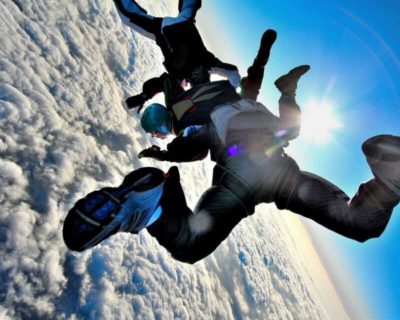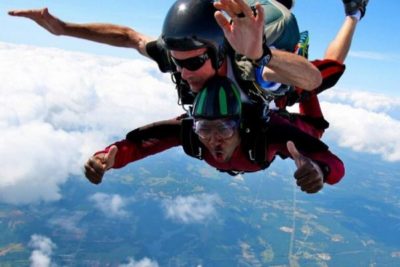As popular as skydiving is, there’s a lot the general public doesn’t know about our beloved sport. Skydiving facts that are based in reality are often hard to come by thanks to pop culture’s portrayal. But learning interesting facts about skydiving proves that our real-life sport is cooler than fiction! When it comes to managing skydiving anxiety, knowing skydiving facts, what to expect, and being prepared for the experience can do wonders for your time in the sky!
Top Skydiving Facts
Ready to be a pro at skydiving trivia? Here are some fun facts about skydiving that will have you jumping out of your seat (and our airplanes):
#1: You Don’t Feel Like You’re Falling
When you jump out of a plane, you’re not actually falling into nothingness. You’re falling into a whole lot of air molecules, and they work together to make you feel like you’re being held up. In the same way that your body would be pushed from the front if you stood in front of a fan blowing 120 miles per hour, your body would be held by the air in freefall.
It’s a really nice feeling – not like the “stomach drop” experience you feel as you go up and down hills on a roller coaster. We like to describe it as a windy floating, and it’s the closest you’ll get to human flight!
#2: Skydivers Focus on Mitigating Risk
Skydivers are portrayed as having a devil-may-care attitude, but it’s quite the opposite. We love jumping out of airplanes … and we want to keep doing it! To do that, we have to complete each jump with a safety-first mentality.
Thanks to consistent research and development, skydiving technology and procedures have advanced significantly over the centuries that the sport has existed. The United States Parachute Association tracks skydiving facts, statistics, rules, and regulations to guide all skydivers on safety issues.
Top-of-the-line equipment also makes a huge difference. At Skydive Monroe, our gear represents the best and latest technology, all of which is regularly inspected and maintained by professionals.
#3: Skydiving is a Competitive Sport
Skydiving may seem like it’s all fun and games (and for some, it is!) but there are professional competitors in the sport as well. Some skydivers even make it their full-time gig. Skydiving athletes are looked up to the same way other people idolize NFL or NBA stars.
The sport of skydiving has regional, national, and international competitions that individuals and teams train countless weeks and months for. Like other sports, we have trophies, medals, record holders, and sponsored athletes. Every skydiving discipline has its competition circuit and set of athletes.
Even for the non-competitive types, skydiving can become a lifelong career. Instructors, dropzone owners, and skydiving school founders are all people who make our sport run like it’s their job (because it is!).
#4: Skydiving Records Are a Thing
Skydivers love to set goals and push limits. As such, countless records are set and broken. Here are a few of the big ones:
 The First Skydive
The First Skydive
We owe this record holder a huge thank you for kicking off everything we love – André-Jacques Garnerin made the first skydive from a balloon in Paris in 1797.
Highest Skydive Ever
This record has been repeatedly broken as technology advances. The current highest skydive record is held by Alan Eustice at 135,890 feet!
Fastest Skydive
Felix Baumgartner held the highest skydive record before Alan broke it, but was able to retain the speed record even after Alan’s jump. Felix reached a speed of 843.6 mph on his jump, which is seven times faster than a typical skydive!
Oldest Skydive
The person who holds this record held it, lost it, and now holds it again! Al Blaschke made a tandem skydive at the spry young age of 106 years and 327 days. #coolgrandpaenergy
Most People on a Skydive
This is another one that sees a lot of turnover as techniques and technology continue to evolve. The current record is shared by 400 people who made one skydive together!
#5: You Cannot Talk While Skydiving
Movies would have you believe that you can have full-on conversations (or arguments about who’s going to pull first) in the middle of freefall. While that plays into the fantastical portrayal of adrenaline junkies and daredevils, it’s not anything like reality.
The 120 mph winds of freefall drown out any bit of sound that may occur thousands of feet in the air like white noise from a jet engine. The wind is whipping past your ears with such speed that you can’t hear anything but the sound of freefall liberation.
You can, however, very easily converse with your tandem instructor once the parachute opens. You’ll slow down considerably (to around 20 mph), and will be able to converse about anything – so ask questions, admire the views, or just ramble about how amazing the jump was.
Insider secret: If you scream loud enough in freefall, your instructor can hear that because they are right behind you. We love to hear you having fun, so let it rip!
#6: Skydiving is Good for the Soul
Skydiving is so much more than just throwing yourself out of an airplane door. There’s a reason so many of us stick around for the long haul. Skydiving leaves a lasting impact on your mind, body, and soul, for example:
- Skydiving has mental benefits that help train your brain to deal with stressful situations. Even just one jump can improve your focus and your ability to manage stress.
- There are real spiritual benefits to skydiving. If you can jump out of an airplane, you can do anything! You’ll notice that difficult things suddenly seem easier, your confidence feels stronger, and the world around you looks lighter.
- Skydiving opens up a whole new worldview that lasts a lifetime. Stepping out of your comfort zone and challenging your mind and body helps you grow!
- With all of these mental and spiritual benefits, skydiving also helps with anxiety!
Reading facts is great, but experiencing them is even better. Come see what we’re talking about – book your jump today!
Copyright © 2025, Skydive Monroe, All Rights Reserved.
DropZone Web Design & Marketing by Beyond Marketing, LLC




